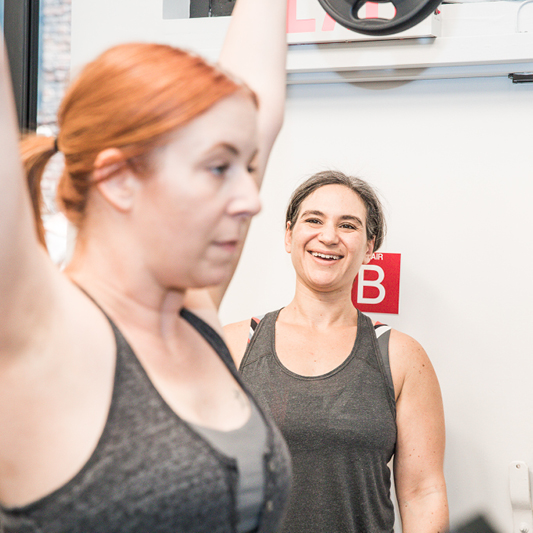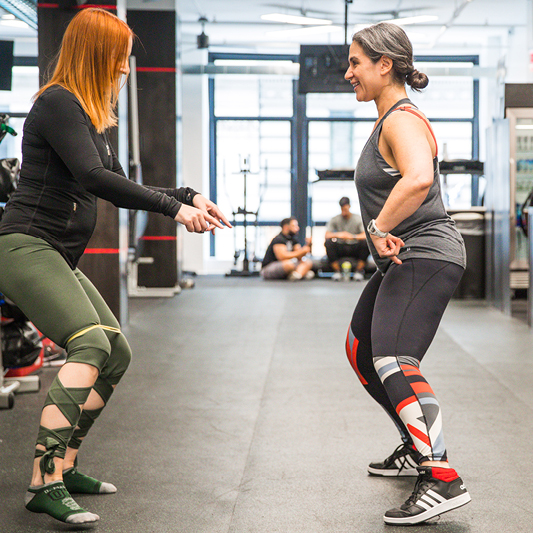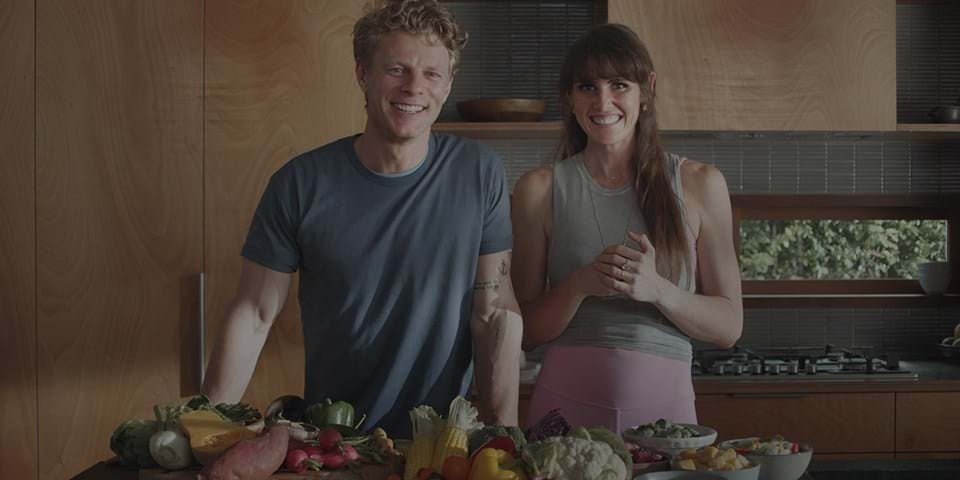Read on and you’ll learn:
• Why all exercise can be meditative
• How to bring mindfulness into your teaching
• How you can become a trauma-informed trainer
• How to make exercise work for your mental health
Laura Khoudari is a trauma practitioner and personal trainer who helps her clients find healing through strength training. She says when it comes to improving our mental health through exercise, it's about being present in our bodies and finding ways to make the movement and environment work for us.
HOW DID YOU GET INTO THIS LINE OF WORK?
Laura Khoudari: "Growing up, I hated exercise: I was the kid who was picked last in gym class. However, at the age of 20 my back went out and I learned I had a herniated disc in my lumbar spine. I was recommended to do physical therapy and strength training, rather than surgery, to correct it. I did the physical therapy and it helped manage the pain – but I was still in pain. I always moved really gingerly, even though I was only in my early twenties. After college, I moved home to New York City and my mother said, 'I’m tired of seeing you walk around like you’re 70. I want you to meet my [personal] trainer.' I said OK, but I was really hesitant.
Big Ed, my mom’s trainer, turned out to be one of the nicest people you’ll ever meet. He made me feel safe in the gym, even though I really didn’t want to be there. I didn't want to be in my body. I didn't want people to see me in my body. I was very self-conscious. I was sort of average in appearance, but I felt really bad about myself and how I appeared from the neck down. I would say things like, 'I'm too fat to go to the gym. I'm not in good enough shape to go to the gym'. And of course, fitness professionals will say, well that's why you go. But it's a really big hurdle to jump. Big Ed made it feel OK to show up. We worked together for many years and my back pain went away. It was wonderful.
In my mid-30s I fell in love with Olympic weightlifting. This was before the boom of CrossFit and so at the time it felt quite subversive for a woman in her 30s to be into Olympic weightlifting and powerlifting. I loved how strong it made me feel; it was very empowering. Unfortunately, it was around that time in my life that I also experienced an acute trauma outside of the gym and developed post-traumatic stress disorder.
The gym had been the place where I felt safe, awesome and strong. And now, all of a sudden, I felt none of these things. I thought that the gym was the only place I could feel strong again and so I started training harder than ever. I was treating my body like it was a machine, and when I started to feel aches and pains, I thought I could train them away.
I started to have pain, but I just ignored. It got worse and eventually my back went out very badly. I was stuck in bed for weeks, months. I had very severe sciatica and I couldn't use my left lower leg very well. For a while, I couldn't walk. I needed to figure out, how can I get back this amazing relationship with myself in the gym, and how can I start training again in a way that feels safe? Because now, not only did I psychologically not feel safe because of trauma, but I also had this physical trauma where it didn't feel safe to put weight on my back again.
I tried trauma-informed yoga, but I found it incredibly triggering. I realized that while the gym was also triggering, I recovered faster from those triggers. I found a coach and I got back to things very slowly. As I started to heal, I realized that I wanted to share my tools with others, and that’s how I came to become a trauma-informed personal trainer."

WHAT'S THE DIFFERENCE BETWEEN BEING TRAUMA-SENSITIVE AND TRAUMA-INFORMED?
"I think that a trauma-sensitive trainer is someone who understands that if their client’s nervous system is overtaxed, they’re more prone to injury and unlikely to progress as well. As trainers we tend to tell people to push through those moments they want to stop, but that’s not always going to help them reach their fitness goals – you’re not honoring the fact that there’s a limitation there. A trauma-sensitive trainer can recognize what trauma looks like in the body. They can offer their clients a safe space so they know that if something comes up for them during the training, they won’t be pushed or shamed in the way you might see in more traditional styles of coaching.
A trauma-informed trainer is somebody who has a deeper understanding of the work required to heal from trauma. When I work with a client, we talk about goals but those goals tend to be along the lines of: wanting to feel grounded, wanting to be able to recover better. If someone is having an intensive amount of therapy, I can help them to recover from that therapy by prioritizing the nervous system and helping them to feel empowered through movement. (These are just my definitions by the way. There’s no regulating authority that gives us these credentials – this is what I’ve seen in my work.)
The first part of trauma recovery is being able to feel safe in your body so you can begin to feel safe in your environment. Without that safety, you can't do all the other healing work like talk therapy or confiding in family members. I see a trauma-informed trainer as working in this more therapeutic fashion. It tends to be adjunctive to work in therapy and building skills that support the client in therapy while also holding the other stuff in mind when designing programs for people.
There's a lot of wonderful trauma-informed expressive movement type classes, and that's great. However, my focus is strength training, the sort of you want to see some progression in – whether that’s to help with chronic pain, postural issues, general discomfort or wanting certain things that will enhance your quality of life. A big one for my clients is being able to carry your groceries, because here in New York we don't usually have cars. Maybe you want to go to the grocery store in the next neighborhood and take the subway with your groceries. A great movement for this would be working on an offset carry, which would help strengthen our shoulders to carry those heavy groceries."
The gym had been the place where I felt safe and awesome and strong. And now, all of a sudden, I felt none of these things. I thought that the gym was the only place I could feel these things again and so I started training harder than ever. I was treating my body like it was a machine, and when I started to feel aches and pains, I thought I could train them away.
AS GROUP FITNESS INSTRUCTORS, WE SPEND MUCH OF OUR TIME FOCUSING ON EVERYONE ELSE DURING THE WORKOUT. HOW CAN WE BE MORE PRESENT IN OUR OWN BODIES?
"Take time to be mindful and in your body outside of class and address any niggles, aches or pains. For example, if your elbows are starting to bother you, you might take five or 10 minutes before class to tune into what your body needs and a really nice, slow-movement practice to target those areas.
It’s also finding ways to be present in your body in other activities. For me, that’s strength training, but it can be literally any activity: brushing your teeth, washing the dishes, walking the dog… You don't have to come up with a new thing. Find something you do regularly that you can turn into a more curious practice about how it feels in your body. It will give you the opportunity to practice checking in with yourself.
This practice of coming into your body and checking in with yourself may help your teaching. Perhaps you check in with your body while you’re teaching a class and you realize the energy in the room is feeling a little heavy, so you want to lighten it up. Or it's feeling a little manic, so you want to bring it down because you're getting close to the end of class. It's going to take a little more focus and being able to adjust on the fly by using your own awareness as a barometer."

WE TRADITIONALLY THINK OF MINDFUL EXERCISE AS BEING SLOW, YOGA-TYPE MOVEMENTS. CAN YOU SHARE HOW STRENGTH TRAINING CAN BE MINDFUL TOO?
The idea of heavy lifting being meditative was actually raised to me by a healer/teacher friend of mine.
Growing up, I had an on again/off again meditation practice. My parents sent me to a super hippy artsy camp during the summer vacation and so I was taking meditation classes at the age of 13. Years later, after I got into Olympic lifting, I shared a video of myself doing some heavy deadlifts on social media. I was talking to this friend of mine and had to confess that I wasn’t meditating every day – and I was feeling sort of bad about it. She said, 'What are you talking about? I see those videos you post on Facebook. You have to be so grounded in your body to do that'.
That was when I realized that lifting can be meditative. It doesn’t have to be pink light and pastels and angels to be healing – although there's nothing wrong with that if that's your thing. But that's not everybody's thing. The place where I felt really good was in barbell clubs. That was my community and it’s where I was feeling safe to be in my body.
The next 'AHA' moment for me was realizing that a single-leg Romanian deadlift is actually the same as a Warrior 3 pose in yoga. You might be holding a kettlebell, but essentially it’s the same movement pattern. There are only so many ways our bodies can actually move. And so, what makes something a more ‘mindful’ movement? It’s about the approach you bring to it.
When I used to go to yoga classes before my back injury, I was there to ‘win’ yoga. I wanted to impress everybody with my movements – not to wonder what it felt like in my body. It wasn’t a mindful practice, it was a performative thing. It helped with a lot of things, but it wasn’t what I call an embodied practice. When I got into weightlifting, in order to move well under load – especially with my history of back pain – I had to be mindful because I didn’t want to get hurt.
There are no mirrors in the barbell clubs. Nobody’s paying attention to you. Everybody’s got their headphones on and are just into their own workouts. I could really do my own thing in my own community – much like showing up to a yoga or mindfulness retreat. You’re there to be in your body with like-minded people."
I realized that lifting can be meditative. It doesn’t have to be pink light and pastels and angels to be healing. The place where I felt really good was in barbell clubs. That was my community and it’s where I was feeling safe to be in my body.
HOW CAN WE BECOME TRAUMA-INFORMED TRAINERS?
"There are a couple of awesome certification programs out now I would recommend. I also offer some mentoring for folks who have some background in this type of training. But to get a good foundation, the lay of the land, there's plenty of great places to start.
I’d recommend reading The Body Keeps The Score by Bessel van der Kolk. For those in the US there are also a couple of great courses: Trauma-Informed Weight Lifting and Trauma-Informed Personal Training Certificate Program from Hope Ignited. I’m sure there are great programs in other countries that can help you gain a foundation, and from there you can figure out which areas you want to explore more deeply."
HOW CAN WE LEARN MORE FROM YOU?
"Read my book! It’s called Lifting Heavy Things: Healing Trauma One Rep At A Time, and while the primary audience would be the client, it also has tons of information for fitness professionals who want to learn more about this topic. It would also be relevant for those therapists who are looking for ways to help their client bring their body more into their work.
It’s a cross-genre book, combining personal narrative along with research and practical exercises to help people create a healing movement practice. If you have a regular movement practice – whether that’s running or strength training or you do BODYCOMBAT™ classes – and you want to learn more about how to deepen it as a self-care practice, this book can help you turn it into more of an embodied healing practice. And for those who don’t have a movement practice but are curious, there are exercises to help you figure out where to start, how to start exploring movement and establish a practice.
The last section is called recovery and it delves into how embodied movement can create changes in the rest of your world: things like relationships and understanding what your boundaries are. I also talk about sharing your trauma story and how to navigate the world of social media."
TOP TIPS TO CREATING AN EXERCISE HABIT THAT SUPPORTS YOUR MENTAL HEALTH
"One of the first things is to examine your intention with movement. For example, if you’re prone to depression or anxiety, these show different things about what your nervous system does when it’s overwhelmed, and you want to work to address those things. Or perhaps your mental health is affecting your sleep, so that means choosing a program that will support better sleep hygiene.
Another big factor is thinking about what you need to feel good in your workout environment, whether that’s in your home, at the gym or outdoors: shaping it so it feels safe for you. You can ask yourself a list of questions like: what time of day are you exercising? What equipment do you need? Do you need gender-neutral bathrooms? Do you want a place that has an explicit commitment to diversity and inclusion? It can be more practical things like, is there a shower that will allow me to get to work on time? If you’re doing an online workout, do you have good enough Wi-Fi connection? If it’s a group class, is it important to you that everyone keeps their camera on? Or, that you don’t have to keep your camera on?
You can also think about the resources you’re bringing with you. This can be as straightforward as a gym membership, or less obvious like – I have a friend who, even though she doesn’t work out herself, still likes to hear about my small victories at the gym. You could carry good luck charms with you to remind yourself of someone or something.
I do think planning and preparing is important to make it stick for the long haul. I encourage people to create a list of things they need for the workout. If you’re having a bad spell and feeling overwhelmed, the list can be a helpful reminder of the resources you need. We can lose our capacity for critical thought when we’re going through a tough time and that’s why having a list can be a helpful reference point. I might be feeling like the world is ending and then I look at my list and it reminds me to tell my husband, David, about a small victory because I know he’ll be really excited for me. Plan to set yourself up for success so it feels good when you show up."
A trauma practitioner, and certified personal trainer, Laura Khoudari is passionate about giving people the tools they need to heal from trauma and cultivate mental health and wellness. Her work has been widely recognized by the trauma and fitness community, and she has been featured on NPR, Buzzfeed, UpWorthy, Outside Online, Medium, Vice, and Nike. She lives in New York City with her family and two cats.
Medium: https://laura-khoudari.medium.com/
Instagram: @laurakhoudari
Twitter: @laurakhoudari
Facebook: @laurakcpt








